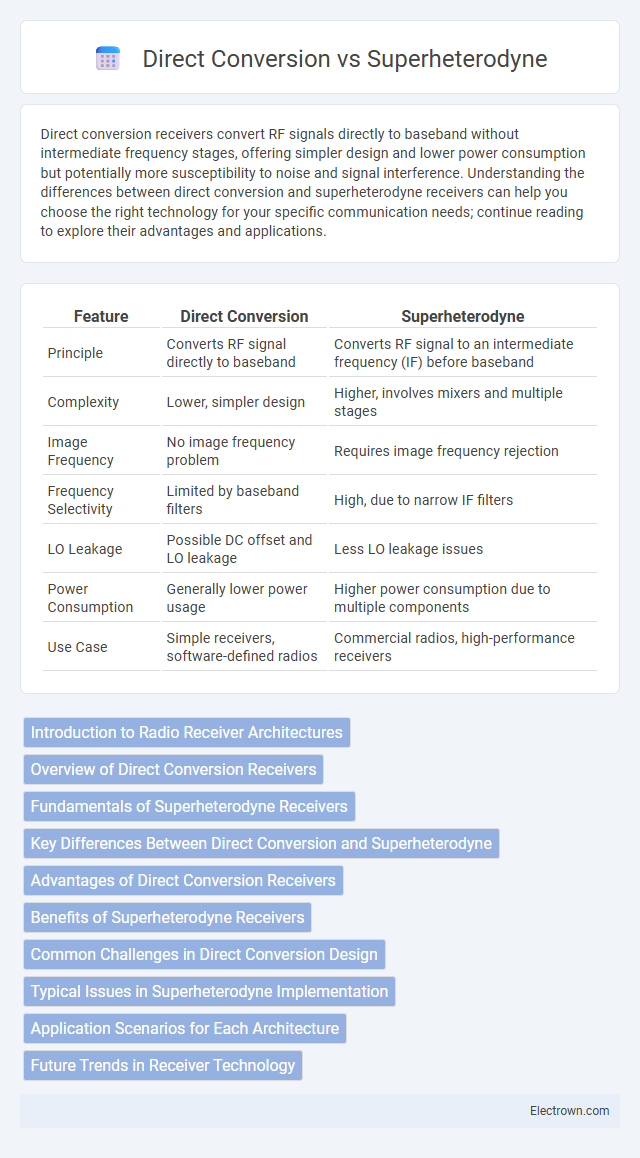Direct conversion receivers convert RF signals directly to baseband without intermediate frequency stages, offering simpler design and lower power consumption but potentially more susceptibility to noise and signal interference. Understanding the differences between direct conversion and superheterodyne receivers can help you choose the right technology for your specific communication needs; continue reading to explore their advantages and applications.
Table of Comparison
| Feature | Direct Conversion | Superheterodyne |
|---|---|---|
| Principle | Converts RF signal directly to baseband | Converts RF signal to an intermediate frequency (IF) before baseband |
| Complexity | Lower, simpler design | Higher, involves mixers and multiple stages |
| Image Frequency | No image frequency problem | Requires image frequency rejection |
| Frequency Selectivity | Limited by baseband filters | High, due to narrow IF filters |
| LO Leakage | Possible DC offset and LO leakage | Less LO leakage issues |
| Power Consumption | Generally lower power usage | Higher power consumption due to multiple components |
| Use Case | Simple receivers, software-defined radios | Commercial radios, high-performance receivers |
Introduction to Radio Receiver Architectures
Direct conversion receivers demodulate the radio frequency (RF) signal directly to baseband without an intermediate frequency (IF) stage, enabling simpler circuit design and reduced component count. Superheterodyne receivers convert the incoming RF signal to a fixed IF using a local oscillator and mixer, improving selectivity and sensitivity through well-established filtering techniques. The choice between direct conversion and superheterodyne architectures depends on application requirements such as complexity, cost, selectivity, and susceptibility to image frequency interference.
Overview of Direct Conversion Receivers
Direct conversion receivers, also known as zero-IF receivers, convert the incoming radio frequency (RF) signal directly to baseband without an intermediate frequency stage. This architecture reduces circuit complexity and power consumption, making it ideal for compact and battery-operated devices. Your communication system benefits from improved integration and faster signal processing, though it may require advanced techniques to handle DC offset and flicker noise.
Fundamentals of Superheterodyne Receivers
Superheterodyne receivers operate by converting a received signal to a fixed intermediate frequency (IF) through mixing with a local oscillator, enabling easier and more selective filtering. This fundamental design improves sensitivity and selectivity compared to direct conversion receivers, which translate the signal directly to baseband without an IF stage. Understanding the IF stage's role in frequency stabilization and noise reduction helps optimize your radio system's performance.
Key Differences Between Direct Conversion and Superheterodyne
Direct conversion receivers mix the incoming RF signal directly to baseband using a single frequency conversion, resulting in simpler architecture and reduced component count. Superheterodyne receivers employ one or more intermediate frequency (IF) stages for frequency conversion, offering superior selectivity and sensitivity through filtering at fixed IF stages. While direct conversion excels in compact design and low power consumption, superheterodyne systems provide better performance in rejecting image frequencies and improving signal fidelity.
Advantages of Direct Conversion Receivers
Direct conversion receivers offer advantages such as simpler circuitry and lower power consumption compared to superheterodyne designs. By converting the received signal directly to baseband, these receivers reduce the need for multiple frequency mixers and intermediate frequency stages, enhancing integration and minimizing component count. Your system benefits from improved signal fidelity and reduced phase noise, making direct conversion ideal for compact, low-cost applications.
Benefits of Superheterodyne Receivers
Superheterodyne receivers provide superior selectivity and sensitivity by converting incoming signals to a fixed intermediate frequency, allowing precise filtering and amplification. This architecture reduces image frequency interference and improves overall signal-to-noise ratio, resulting in clearer, more reliable reception. Your communication system benefits from the robust performance of superheterodyne designs, especially in complex signal environments.
Common Challenges in Direct Conversion Design
Direct conversion receivers face common challenges such as DC offset, I/Q imbalance, and flicker noise, which degrade signal quality and increase design complexity. LO leakage and even-order distortion can create unwanted interference, complicating the filtering and calibration processes. Unlike superheterodyne architectures that benefit from intermediate frequency filtering, direct conversion demands sophisticated baseband signal processing to mitigate these impairments effectively.
Typical Issues in Superheterodyne Implementation
Superheterodyne receivers commonly face image frequency interference and require complex filtering to suppress unwanted signals, increasing design complexity and cost. Local oscillator phase noise and frequency stability directly affect receiver performance, leading to spurious responses and reduced sensitivity. Additionally, intermediate frequency (IF) stages can introduce distortion and limit bandwidth flexibility, challenging efficient signal processing.
Application Scenarios for Each Architecture
Direct conversion receivers are ideal for applications requiring simple design and low-power consumption, such as mobile devices and software-defined radios, where integration and cost efficiency are critical. Superheterodyne receivers excel in high-performance scenarios demanding superior selectivity and sensitivity, including broadcast radio, radar systems, and military communications. The choice depends on factors like frequency range, signal environment, and size constraints, with superheterodyne favored for complex, high-frequency applications and direct conversion suited for compact, low-frequency settings.
Future Trends in Receiver Technology
Future trends in receiver technology highlight a growing focus on direct conversion due to its simpler architecture, improved integration capabilities, and lower power consumption compared to superheterodyne receivers. Advances in software-defined radio and digital signal processing further enhance direct conversion's adaptability and performance in diverse wireless applications. Your ability to leverage these innovations will enable more compact, efficient, and versatile communication devices.
direct conversion vs superheterodyne Infographic

 electrown.com
electrown.com